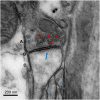Imaging Synaptic Density: The Next Holy Grail of Neuroscience?
- PMID: 35401097
- PMCID: PMC8990757
- DOI: 10.3389/fnins.2022.796129
Imaging Synaptic Density: The Next Holy Grail of Neuroscience?
Abstract
The brain is the central and most complex organ in the nervous system, comprising billions of neurons that constantly communicate through trillions of connections called synapses. Despite being formed mainly during prenatal and early postnatal development, synapses are continually refined and eliminated throughout life via complicated and hitherto incompletely understood mechanisms. Failure to correctly regulate the numbers and distribution of synapses has been associated with many neurological and psychiatric disorders, including autism, epilepsy, Alzheimer's disease, and schizophrenia. Therefore, measurements of brain synaptic density, as well as early detection of synaptic dysfunction, are essential for understanding normal and abnormal brain development. To date, multiple synaptic density markers have been proposed and investigated in experimental models of brain disorders. The majority of the gold standard methodologies (e.g., electron microscopy or immunohistochemistry) visualize synapses or measure changes in pre- and postsynaptic proteins ex vivo. However, the invasive nature of these classic methodologies precludes their use in living organisms. The recent development of positron emission tomography (PET) tracers [such as (18F)UCB-H or (11C)UCB-J] that bind to a putative synaptic density marker, the synaptic vesicle 2A (SV2A) protein, is heralding a likely paradigm shift in detecting synaptic alterations in patients. Despite their limited specificity, novel, non-invasive magnetic resonance (MR)-based methods also show promise in inferring synaptic information by linking to glutamate neurotransmission. Although promising, all these methods entail various advantages and limitations that must be addressed before becoming part of routine clinical practice. In this review, we summarize and discuss current ex vivo and in vivo methods of quantifying synaptic density, including an evaluation of their reliability and experimental utility. We conclude with a critical assessment of challenges that need to be overcome before successfully employing synaptic density biomarkers as diagnostic and/or prognostic tools in the study of neurological and neuropsychiatric disorders.
Keywords: GluCEST; PET; SV2A; electron microscopy; immunohistochemistry; synaptic density.
Copyright © 2022 Serrano, Kim, Petrinovic, Turkheimer and Cash.
Conflict of interest statement
The authors declare that the research was conducted in the absence of any commercial or financial relationships that could be construed as a potential conflict of interest.
Figures






Similar articles
-
Development and In Vivo Preclinical Imaging of Fluorine-18-Labeled Synaptic Vesicle Protein 2A (SV2A) PET Tracers.Mol Imaging Biol. 2019 Jun;21(3):509-518. doi: 10.1007/s11307-018-1260-5. Mol Imaging Biol. 2019. PMID: 30084043
-
Assessing Synaptic Density in Alzheimer Disease With Synaptic Vesicle Glycoprotein 2A Positron Emission Tomographic Imaging.JAMA Neurol. 2018 Oct 1;75(10):1215-1224. doi: 10.1001/jamaneurol.2018.1836. JAMA Neurol. 2018. PMID: 30014145 Free PMC article.
-
Imaging synaptic density in the living human brain.Sci Transl Med. 2016 Jul 20;8(348):348ra96. doi: 10.1126/scitranslmed.aaf6667. Sci Transl Med. 2016. PMID: 27440727 Clinical Trial.
-
SV2A PET imaging in human neurodegenerative diseases.Front Aging Neurosci. 2024 Apr 18;16:1380561. doi: 10.3389/fnagi.2024.1380561. eCollection 2024. Front Aging Neurosci. 2024. PMID: 38699560 Free PMC article. Review.
-
Synaptic Vesicle Glycoprotein 2A: Features and Functions.Front Neurosci. 2022 Apr 28;16:864514. doi: 10.3389/fnins.2022.864514. eCollection 2022. Front Neurosci. 2022. PMID: 35573314 Free PMC article. Review.
Cited by
-
Shock and kill within the CNS: A promising HIV eradication approach?J Leukoc Biol. 2022 Nov;112(5):1297-1315. doi: 10.1002/JLB.5VMR0122-046RRR. Epub 2022 Sep 23. J Leukoc Biol. 2022. PMID: 36148896 Free PMC article. Review.
-
Cell-specific spatial profiling of targeted protein expression to characterize the impact of intracortical microelectrode implantation on neuronal health.J Mater Chem B. 2024 Dec 4;12(47):12307-12319. doi: 10.1039/d4tb01628a. J Mater Chem B. 2024. PMID: 39479901 Free PMC article.
-
Recently recycled synaptic vesicles use multi-cytoskeletal transport and differential presynaptic capture probability to establish a retrograde net flux during ISVE in central neurons.Front Cell Dev Biol. 2023 Nov 6;11:1286915. doi: 10.3389/fcell.2023.1286915. eCollection 2023. Front Cell Dev Biol. 2023. PMID: 38020880 Free PMC article.
-
Detection and treatment of Alzheimer's disease in its preclinical stage.Nat Aging. 2023 May;3(5):520-531. doi: 10.1038/s43587-023-00410-4. Epub 2023 May 18. Nat Aging. 2023. PMID: 37202518 Free PMC article. Review.
-
Advances in synaptic PET imaging and intervention with synapse-targeted small-molecular drugs for dementia diagnosis and therapy.Fundam Res. 2024 Apr 21;5(1):63-71. doi: 10.1016/j.fmre.2024.04.013. eCollection 2025 Jan. Fundam Res. 2024. PMID: 40166112 Free PMC article. Review.
References
Publication types
LinkOut - more resources
Full Text Sources

